|
|
|
| Published
on 6
Apr
2013 |
All rights reserved.
|
|
|
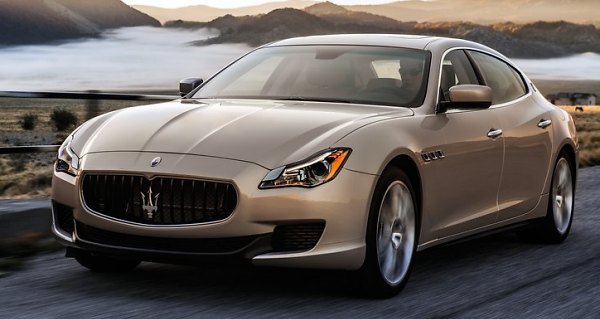
|
Global sales of
luxury cars have been outpacing the overall market in the past decade.
10 years ago, BMW, Mercedes and Audi combined to sell 3 million cars a
year. Now the figure has grown to 4.75 million cars. Envying the
success of German, Fiat group wants its Maserati division to take a
larger slice of the luxury market. Last year, the Modena
company delivered only 6,288 cars. By 2015, it has to sell 50,000 cars,
or 8 times the current level. How can this be achieved? The answer lies
on new models, of course. Later this year Maserati will add a mid-size
sports sedan called Ghibli. It should rival Audi S6 and BMW M5 / M550d
in a segment Modena used to omit. Next year will come Levante, the
first SUV of the Italian sportscar brand (and undoubtedly a
controversy). 2015 will see the next generation
GranTurismo/GranCabrio. However, right now the most important is
launching the 6th generation Quattroporte luxury saloon. Thanks to the
addition of Ghibli, now it can be made larger and aim more squarely at
F-segment rivals like Audi A8/S8, Mercedes S600/S63, BMW 750/760 and
Jaguar XJ
Supersport/XJR. That will give it access to much wider audiences,
hence potentially multiple times of demand. China is especially the
most promising market for such luxury limousines.
However, that sounds not very amusing to the fans of the old
Quattroporte like us. Being larger and more mainstream could mean
losing the old car's unique character – that sporty and engaging
handling, that intoxicating scream of Italian high-revving V8 as well
as the sense of occasion shown in its exterior design and interior
craftsmanship. In fact, such a charming character let the old car to
overcome its deficit in performance and consistently topped our
F-segment performance car chart during the past 9 years! How can we be
not worried?
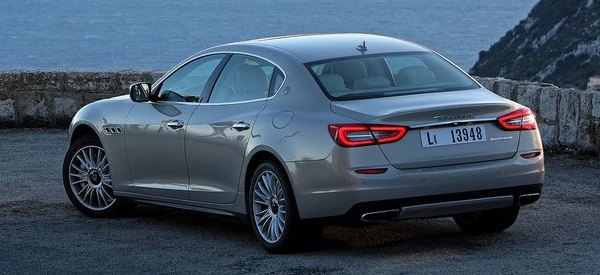
|
At 5263 mm, the new Quattroporte is even longer than a
long-wheelbase S-class, while its 1948 mm width exceeds the Mercedes
limousine by 77 mm. Equally jaw-dropping is the 3171 mm wheelbase,
which is the longest in class. Besides, the Quattroporte is also pretty
tall at 1481 mm, i.e. 33 mm taller than Jaguar XJ. This car is really
huge!
As a result, the cabin becomes a lot more spacious. While the old car
was no roomier than a BMW 5-Series, the new car is as roomy as an
S-class. Its rear passengers enjoy the greatest benefit, with a massive
105 mm more legroom to stretch. Chinese millionaires will enjoy to be
chauffeured in this Maserati limo. Well, the Quattroporte is still
intended to be a driver's car, but it no longer descends the rear seat
passengers to second-class citizens.
Nevertheless, the new cabin is not all about good news. Yes, its simple
design looks modern and intuitive to use. The new touchscreen
infotainment system is million miles better than the crappy item on the
old car, even though it actually comes from Dodge Dart. There is also
plenty of wood, leather and alloy wrapping all
surfaces, but the materials and build quality is a bit let down. It
feels more Infiniti than Maserati, lacking the Italian craftsmanship
traditionally linked with the marque. Maybe the production car will be
better made than the pre-production sample, but I suspect the change of
assembly location could be a factor – instead of Modena, its production
takes place at the Grugliasco plant near Turin, which was acquired from
Bertone a couple of years ago. It used to produce the old Opel Astra
Coupe and BMW C1
scooter, so it might lack the necessary skill to build a luxury car
like this. Moreover, some Chrysler-sourced switchgears feel out of
place with the expensive car, lacking the tactility of German and
British rivals.
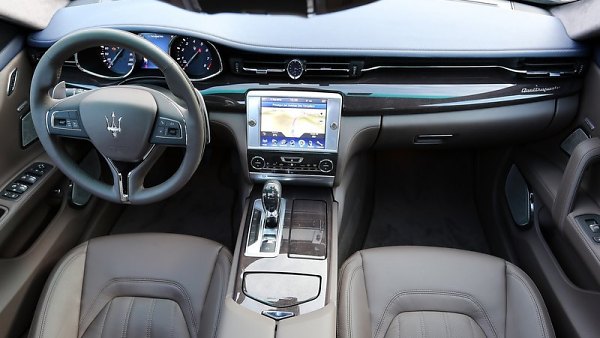
|
The exterior is slightly better. The new car was designed by
Fiat itself instead of Pininfarina (poor Pinin!). It keeps trademark
features like the unique radiator grille, 3 side air outlets
and a slightly cab-rearward profile. There are more sharp edges to
create tension on the body surface. The design masks the massive length
reasonably well, but it doesn't possess the charm of the old car. I am
especially displeased with the addition of rear quarter windows, which
damages the uncluttered feel of the old car and reduces the triangular
effect of the C-pillars. This make the new car looks more mainstream
and less unique. The tail can be more special, too.
On the plus side, the new shape is more slippery. Its drag coefficient
of 0.31 might be nothing to be proud of these days, but it is already a
lot better than the old car's 0.35. Lift is also reduced by 24 percent.
For a car so large, its 1900 kg kerb weight is quite remarkable. It is
about the same as the aluminum-spaceframe XJ Supersport, 75 kg lighter
than an Audi S8 and 145 kg lighter than a steel-bodied S63 AMG. Most
important, it undercuts the old Quattroporte by 90 kg. The chassis is
essentially a steel monocoque, but it employs plenty of light aluminum
parts, such as the front subframe, cross strut, front shock towers,
suspensions, front fenders, bonnet, boot lid and all 4 doors. Besides,
the dashboard cross strut is made of magnesium. Weight distribution is
a "perfect" 50:50, but from the viewpoint of skilled drivers it is
actually not as perfect as the 47:53 of the old car. Obviously,
Maserati has moved the engine forward to liberate more interior space
and abandoned the rear-mounted transaxle for a conventional
front-mounted one. The latter change has two reasons: to enable the
very good ZF 8-speed automatic to be fitted, and to make 4WD option
possible. The 4WD system will be available to the V6 engine. We'll
leave it until it goes on sale later this year. For the rear-drive
model, a mechanical LSD comes standard.
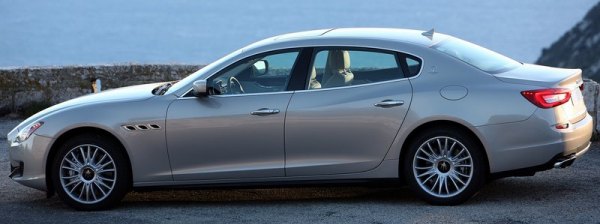 |
In line with current trend, the suspension up front is
double-wishbone, while the rear is a 5-link setup. They are backed up
with Skyhook adaptive dampers like the last generation. Braking should
be remarkable, as it employs large Brembo dual-cast ventilated and
cross-drilled discs with 380 mm front and 350 mm rear, accompanied with
6 and 4-piston calipers respectively.
What about the engine? It is still a Ferrari V8, but this time
downsized to 3.8 liters and added with twin-turbo. If you let me
choose, I would always prefer a naturally aspirated engine for sharper
throttle response. Anyway, the outgoing 4.7-liter engine has run out of
room for enlargement. Even if it could be enlarged to 5 liters, it
would not have been possible to deliver the thick low-end torque that a
heavyweight limousine needs, which is what exactly the old car cried
for. The new Maranello-designed and built unit has its technology
updated, including dual-VVT (instead of intake VVT), roller finger
followers, direct injection and a pair of low-inertia twin-scroll
turbochargers with individual intercoolers. The turbos are integrated
with the exhaust manifolds to save weight and reduce lag. On-demand
ancillaries and a lazier mode called ICE enables it to reduce fuel
consumption and emission by 20 percent from the old engine. Meanwhile,
the new motor pumps out 530 horsepower at 6800 rpm and 479 pound-foot
of torque between 2000 and 4000 rpm. An overboost to 524 lbft is
possible from 2250 to 3500 rpm. This is not only far more powerful and
torquey than the old engine, but also a match to its larger capacity
German rivals.
However, turbocharged or not, an Italian V8 is still more characterful
than German ones. It is noticeably more eager to rev, as implied by its
7200 rpm redline and 6800 rpm power peak, thanks to its smaller
capacity and oversquared combustion chambers (86.5 mm bore x 80.8 mm
stroke). It also roars angrier at high rev, once the exhaust bypass
valve opens.
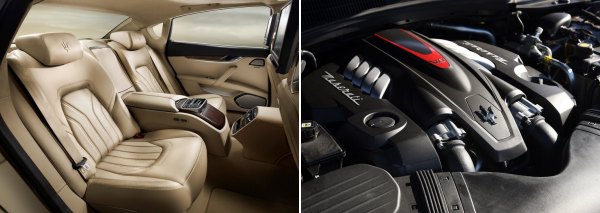
|
The new V8 enables the Quattroporte to accelerate from 0-60
mph in 4.5 seconds, a considerable improvement from the old car's 4.9
sec. Top speed is lifted from 177 to 191 mph. Maserati claims it to be
the fastest 4-door saloon in the world, which is not true, because
Bentley Continental Flying Spur Speed is good for 200 mph.
Nevertheless, in the real world the new Quattroporte feels quicker than
the figures suggested. Its new-found torque and its responsive ZF
8-speed gearbox enables it to overcome its weight with ease.
Acceleration is instantaneous, unlike the old naturally aspirated V8
which needs to be revved hard yet delivered much less. You do miss the
old engine's rev-happy character, keener throttle response and its even
better sound, but the extra performance it offers is more than enough
to compensate. Meanwhile, the 8-speed gearbox is a sizable improvement
from the old 6-speeder. Its gearshift is impeccably smooth, responsive
and accurate, and it never selects a gear wrong.
At low speed, the V8 is a different animal. It is as smooth and quiet
as a limousine deserved. This dual-character makes the car a
comfortable one when driven leisurely or an exciting one when driven
hard.
A 410 hp 3.0-liter twin-turbo direct-injected V6 will be offered as a
cheaper alternative. With a 60-degree V-angle instead of 90-degree, it
is not exactly a modular derivative of the V8, but it employs much the
same technology. Again, I will leave my judgment until it is available
later this year.
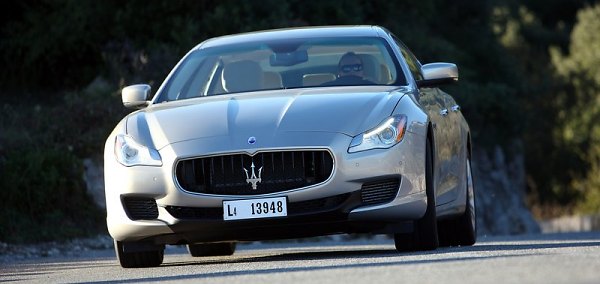
|
How does the chassis behave on road? As it grows much wider
and longer, the new car no longer slips into narrow country roads with
confidence. You are always aware of the traffic at the opposite lane,
so it is difficult to exploit its performance on such roads. Give it a
wider road, you will find the new car is still remarkably neutral to
steer. It resists body roll and understeer strongly, but it is no
longer as easy to induce power slide at will, because the longer
wheelbase introduces higher stability to the handling. The overall
feeling is a more composed, more matured character. The grip it
produced is excellent. Same goes for the powerful brakes.
The steering is still hydraulic assisted, no wonder it feels natural.
It is quicker and reassuringly heavier than the old helm. What the new
car doesn't match its predecessor is turn-in response. Blame to the
50:50 weight distribution and higher polar moment of inertia, it
doesn't feel as razor sharp to steer. Following your steering action,
the big body hesitates a moment before its suspension settles and turns
into corner. This more inert manner shifts the new Quattroporte closer
to the camp of Jaguar XJ Supersport. In other words, it no longer feels
like a four-door sports car, sadly.
On the other hand, it isn't as smooth and quiet to ride as the Jaguar.
Its suspension is firmer even in the softest setting. This results in a
rather harsh ride on B-roads, although on highway at speed it is
perfectly composed. The noise insulation is also less remarkable than
conventional limousines. There is noticeably more road and wind noise
entering the cabin, probably through the better looking frameless
windows.
However, the biggest disappointment is still the big Maserati has
traded its soul for more sales. The new car might be faster, more
comfortable and overall more capable, but it also gets more ordinary in
the process. To the fans of the old Quattroporte, this is hard to
accept.
|
Verdict:     |
| Published
on 20
May
2013 |
All rights reserved.
|
|
Quattroporte S V6 Q4
|
|
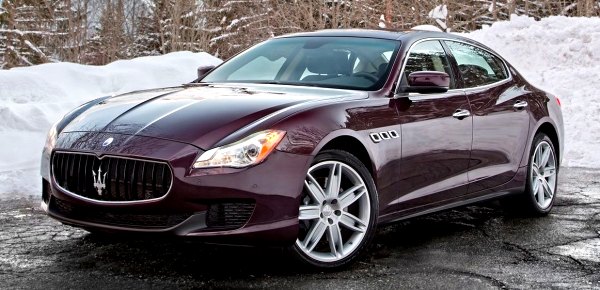
|
The V6 version of
Quattroporte costs 25 percent less than the V8 GTS, but it is 120
horsepower down. Does it deserve the trident badge? That depends on
your view. If you buy Maserati purely for its performance edge and
aural thrills, then I would say the V8 is a more worthy investment.
However, as Maserati wants to lure less hardcore drivers from the camp
of German luxury saloons like Audi A8, BMW 750i and Mercedes S500 to
widen its customer portfolio and increase sales, the V6 could have a
better chance. This is especially true as the V6 can be equipped with
the Q4 all-wheel drive system, which should help its attraction in
snow-belt countries including North America.
Like the V8, the V6 is engineered and built by Ferrari based on the
same technologies, including direct injection, dual-VVT and twin-turbo.
However, it is not exactly the V8 with 2 cylinders chopped away, as you
can see from its 60-degree V-angle. Displacing 2979 cc, it has the same
86.5 mm bore but a longer stroke at 84.5 mm instead of 80.8 mm. This
mean it is not as revvy – it cuts fuel at 6500 rpm instead of 7000 rpm.
Despite that, it is still capable of producing a remarkable 410
horsepower, just 30 hp shy of the last 4.7-liter Quattroporte, and
trumps the latter with 45 pound-foot more torque. As its peak torque is
available from 1500 rpm all the way to 5000 rpm, its performance is a
lot more accessible than the old car, too. Furthermore, the rear-drive
V6 weighs some 130 kg less than the old car, no wonder it quotes the
same performance – 177 mph top speed and
0-60 mph in 4.9 seconds. Admittedly, the German rivals are even faster,
but I suppose few people would complain the Maserati for being slow.
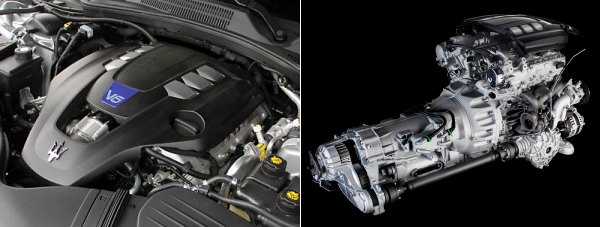
|
Opted for the Q4 system, the superior traction will minus
the 0-60 mph sprint by a further 0.2 seconds. The Q4 is supplied by
Magna, which has been offering a similar system to BMW under the trade
name "xDrive" for a long time. In normal driving it is basically
rear-drive. When tire
slip is detected it engages the multi-plate clutch to distribute torque
to the front axle. The front to rear torque split could be adjusted
between
0:100 and 50:50 depending on needs. The transfer case is bolted just
behind the ZF 8-speed automatic transmission. The system weighs only 60
kg thus it has little influence to weight distribution.
In the real world, the V6 feels strong and eager. It doesn't bark as
angrily as its V8 brother, let alone the old naturally aspirated V8,
but compared with the civilized interpretation of German luxury saloons
it is definitely more exciting to hear, thanks to the crackle on engine
overrun, so it still deserves the Trident badge. Maserati's hydraulic
power steering is weightier and more feelsome than those of its rivals.
Its handling is also more neutral. The AWD system feels mostly
rear-drive but it adds extra security when you need it. Only when you
push it very hard you can feel more understeer than the RWD version. On
the downside, the Quattroporte never rides as smooth and quiet as its
rivals. It absorbs big bumps good enough, but it fidgets on smaller
road irregularities. After all, sporting is still part of the
Maserati's DNA. Its buyers will be happy to see it keeping the
traditional character while offering more space, creature comfort,
safety and a lower entry price. While our hearts choose the V8 GTS, the
V6 S Q4 appeals more to our heads.
|
Verdict:     |
|
|
|
|
|
|
|
|
|
|
Quattroporte S V6 (Q4)
|
2013
|
Front-engined,
RWD (4WD)
|
Steel monocoque, aluminum sub-frame
|
| Aluminum + steel |
| 5262 / 1948 / 1481 mm |
| 3171 mm |
V6, 60-degree
|
| 2979 cc |
DOHC 24 valves, DVVT
|
| Twin-turbo |
| DI |
410 hp / 5500 rpm
|
406 lbft / 1500-5000 rpm
|
8-speed automatic
|
F: double-wishbones
R: multi-link
|
Adaptive damping
|
F: 245/40ZR20
R: 285/35ZR20
|
1860 kg (1930 kg)
|
177 mph (c) (176 mph (c))
|
4.9 (c) (4.7 (c))
|
| - |
|
Quattroporte GTS V8
|
2013
|
Front-engined,
RWD
|
Steel monocoque, aluminum sub-frame
|
| Aluminum + steel |
| 5262 / 1948 / 1481 mm |
| 3171 mm |
V8, 90-degree
|
| 3799 cc |
DOHC 32 valves, DVVT
|
| Twin-turbo |
| DI |
530 hp / 6800 rpm
|
479 lbft / 2000-4000 rpm
(overboost 524 lbft)
|
| 8-speed automatic |
F: double-wishbones
R: multi-link
|
Adaptive damping
|
F: 245/40ZR20
R: 285/35ZR20
|
1900 kg
|
191 mph (c)
|
4.5 (c) / 4.2*
|
| 10.3* |
|
|
|
|
|
|
Performance
tested by: *C&D
|
|
|
|
|
|
|
|
|
Copyright©
1997-2013
by Mark Wan @ AutoZine
|
|